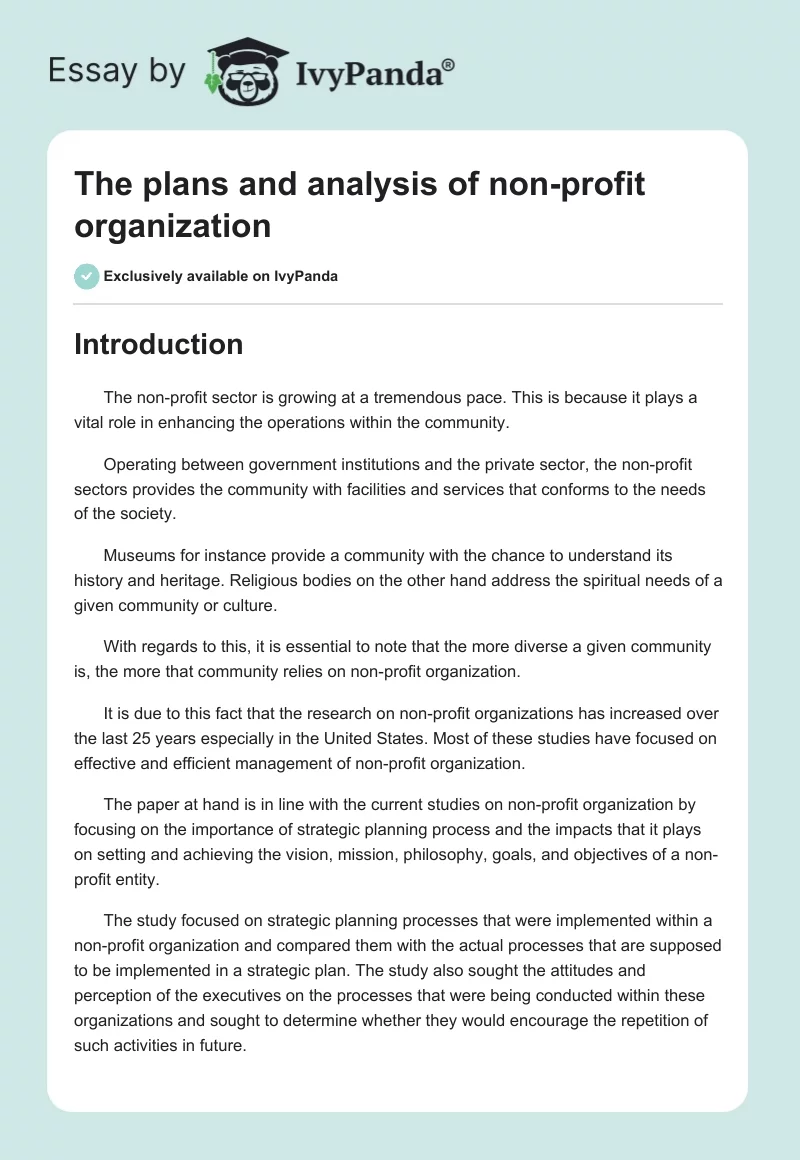Introduction
The non-profit sector is growing at a tremendous pace. This is because it plays a vital role in enhancing the operations within the community.
Operating between government institutions and the private sector, the non-profit sectors provides the community with facilities and services that conforms to the needs of the society.
Museums for instance provide a community with the chance to understand its history and heritage. Religious bodies on the other hand address the spiritual needs of a given community or culture.
With regards to this, it is essential to note that the more diverse a given community is, the more that community relies on non-profit organization.
It is due to this fact that the research on non-profit organizations has increased over the last 25 years especially in the United States. Most of these studies have focused on effective and efficient management of non-profit organization.
The paper at hand is in line with the current studies on non-profit organization by focusing on the importance of strategic planning process and the impacts that it plays on setting and achieving the vision, mission, philosophy, goals, and objectives of a non-profit entity.
The study focused on strategic planning processes that were implemented within a non-profit organization and compared them with the actual processes that are supposed to be implemented in a strategic plan. The study also sought the attitudes and perception of the executives on the processes that were being conducted within these organizations and sought to determine whether they would encourage the repetition of such activities in future.
Methodology
Relevant data for the study was collected through the administration of questionnaires. These questionnaires were designed to focus on strategic management process of non-profit organization. To achieve this, the questionnaires contained 43 elements that are critical in the strategic management process. Of these elements, an assessment of the executive focused on the degree of:
- Current application
- Desirable application
These elements were measured on a 5-point scale with 5 relating to a strong agreement and 1 relating to strong disagreement.
- The questionnaires were sent to the respondents (non-profit organization executives) via mail.
- A sample of 150 non-profit directors in the greater Philadelphia region formed the sample group of the study. Equal number of respondents from churches, museums, and human groups were selected.
- As a form of motivation to increase the level of participation, those respondents who took part in the exercise were invited to a presentation on strategic planning.
Results
Of the 150 questionnaires that were sent put, only 53 responses were returned.
Additionally, the 43 strategic management elements that were being tested by the questionnaire were averaged into the following six main elements:
- Participation
- Organization mechanisms
- Plan development responsibilities
- Inputs and analyses
- Elements in the resultant plans
- Promulgation elements in the plans
From an analysis of the results, it was evident that strategic planning processes usually drive non-profit organizations. However, the level at which these processes were implemented were not desirable to the non-profit organization executives and directors. This was because most of them felt that inputs and analyses of the strategic planning process to be deficient.
Furthermore, the rate at which the strategic planning process was being applied in non-profit making organization was lower than expected.
Discussion
The fact that the directors of non-profit organization feel that the plans and analyses of the strategic planning process are deficient is alarming.
This is because it is through these plans and analysis that goals and objectives of an organization are realized.
Thus, with these flaws, it is difficult for such organization to achieve their mission, vision, goals, and objectives.
The plans and analysis of non-profit organization may be deficient due to proper allocation of time, participation, inputs of the entire process.
However, it should be noted that the results of this study could not be generalized due to the small sample size of the study and the limited geographical size of the study area.


 3.43
3.43
